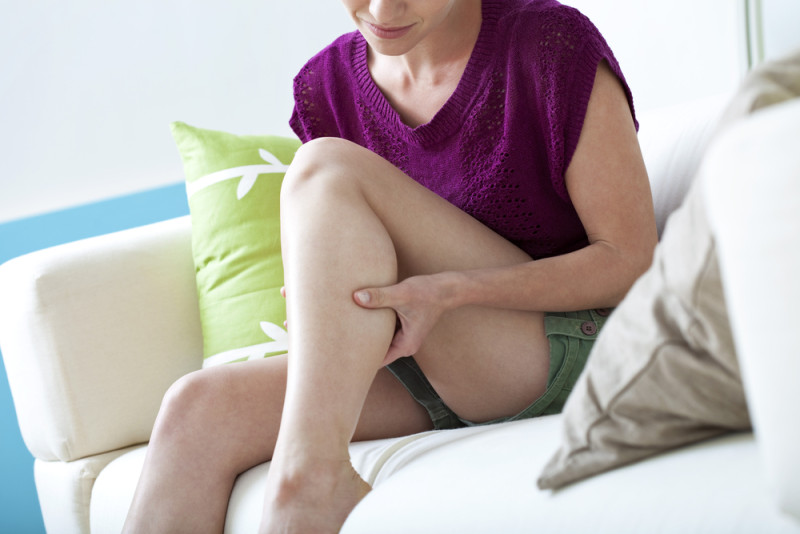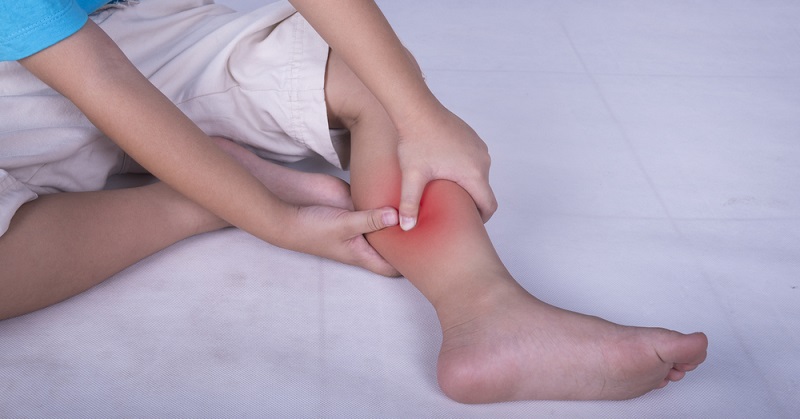Have you ever had a muscle cramp? Usually people experience cramps in the legs, so often we talk about “leg cramps.” But a muscle cramp can happen anywhere in your body.
Muscle or leg cramp pain can be absolutely excruciating, but there are remedies available to offer you relief. A muscle cramp that happens during the night usually comes in the form of a sudden spasm or tightening of the muscles in the calf, feet, or thighs. You may have heard this referred to as a charlie horse. Leg cramps often occur just as you are falling asleep, or soon upon waking. They can even wake you in the middle of the night–and what a rude awakening it is! The pain can be unbearable and can last from seconds to minutes. However, some have reported their muscle cramp lasting as long as a day! When the pain finally disappears, the muscles feel tight and may often still be painful.
Nighttime leg cramps are different from Restless Leg Syndrome. Both occur at night, but in Restless Leg Syndrome, moving the legs brings relief. Moving during a cramp will result in more pain. The cause of a muscle cramp is often hard to determine. It may be brought on by several different conditions or activities, including:
- Exercising
- Injury
- Overuse of Muscles
- Pregnancy
- Calcium Deficiency
- Magnesium Deficiency
- Potassium Deficiency
- Exposure to Cold Temperatures
- Kidney Disease
- Thyroid Disease
- Blood Flow Problems
- Certain Medications
- Dehydration

If you suspect your leg cramps are caused by something else more serious, be sure to speak to your physician. This is especially true if your leg cramps are persistent. If the muscle cramps you’re experiencing aren’t an indication of a more serious underlying condition, however, there are several natural ways you can treat them. Furthermore, these methods are great for preventing painful muscle cramps.
Here are 6 steps to easing your muscle or leg cramp:
1. Stretching
Try to relax the muscle that’s cramping. Stop performing any activity that may have induced the cramp and lightly stretch the muscle. Hold the stretch for at least 45 seconds and massage the muscle while you’re stretching it. To prevent future muscle cramps, you should be stretching on a daily basis.
2. Acupuncture or Massage
Acupuncture can help to relax the muscles and get to the core of the problem. If needles aren’t your thing, try getting a massage on a regular basis to keep muscles from getting too tight. Not only will this help ease your muscle cramp, but it’s also a fantastic way to help relieve every-day stress. Your massage therapist may be able to give you some tips, such as stretching, to help target specific problem areas.
3. Epsom Salt Bath
Many coaches, therapists and personal trainers recommend this method for cramping. Take a warm bath with Epsom salts — it will provide magnesium to the outside of your body, and the warm water will help to sooth your muscles. This is also a great way to relax and help de-stress after a long day. For the ultimate relaxing atmosphere, play some soothing music for you to enjoy while in the bath, or try lighting some aromatherapy candles.
4. Drink More Water
Our lives often become busy enough to the point where it’s easy to neglect water consumption. This can lead to dangerous conditions such as dehydration. And, it just so happens, dehydration is a common cause of muscle cramping. Of course, downing a bottle of water when you get a cramp probably won’t work as a quick fix. However, making sure to drink enough water each and every day will help to hydrate your body on a regular basis and prevent cramping in the future. You should opt to drink water whenever you can. Carry a large reusable water bottle with you wherever you go and refill it as often as you can with pure, filtered water.
5. Stay Active
Going for a walk can help to eliminate cramping due to the contracting and relaxing of the leg muscles. Keeping muscles from remaining still for too long and becoming stiff can help prevent cramps. Be sure to stretch after, and perhaps during your walk, to further help prevent and treat muscle cramps. Hold each stretch for at least 45 seconds. Additionally, avoid sitting in one position for too long. Many of us work jobs that entail sitting for long periods of time. However, you should try to get up and move around for a while (or at least change your position) every ten minutes or so.
6. Magnesium
An Epsom salt bath can offer your body more magnesium externally, and eating more magnesium-rich foods can do the same internally. If you don’t regularly have leg cramps that are not related to a more serious condition, try adding more magnesium to your diet. Nuts and seeds, for example, are excellent natural sources of magnesium. You can also eat avocados, spinach, figs, or bananas for extra magnesium. Talk to your doctor, however, before taking any magnesium supplements to your routine.
What to Do During a Muscle Cramp
The remedies listed above are preventative measures. So what is one to do while experiencing a muscle cramp? Leg cramps during the night, in particular, can be extremely painful and even feel paralyzing. Try to remember these few tips to help with the pain.
- For immediate relief, get your leg out of bed and allow it to carry your weight on the ground. Step down on the floor and, balancing, lean into your leg. This method will usually stop the clinching pain.
- From there, get up from the bed if you can and try to move the leg; walk around to stimulate blood flow.
- Massage the muscle in circular motions.
- Make sure your sheets, blankets, and bedtime clothing are loose and breathable.
- Sit on the floor and extend your legs out in front of you. Flex your feet at the ankles and point the toes. Then use your hands to pull your feet and slowly stretch the muscles. Hold the stretch for as long as you can, but aim for 45 seconds. Don’t stretch further than your comfort zone, or you could risk further injury. Remember, while this method will help relieve a cramp in the moment, prevention is usually key. Aim to stretch and exercise your muscles every day to avoid muscle cramps.


